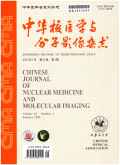18F-FDG PET/CT影像组学在预测肺腺癌患者EGFR突变中的价值
Ability of 18F-FDG PET/CT radiomic features to differentiate EGFR mutation status in patients with lung adenocarcinoma
摘要目的:分析并比较 18F-脱氧葡萄糖(FDG)PET及CT影像组学参数在预测肺腺癌患者表皮生长因子受体(EGFR)表达中的作用。 方法:回顾性收集2017年1月至12月间于南方医院就诊的114例[男64例,女50例,年龄35~84(平均61)岁]肺腺癌初治患者的治疗前 18F-FDG PET/CT图像及其EGFR表达资料。用LIFEx软件手动逐层勾画感兴趣体积并提取图像参数,通过最小绝对收缩和选择算子(LASSO)方法重复200次进行参数选择,经十倍交叉验证选择模型的最优调和参数λ,再采用logistics逐步回归进一步筛选参数建模。针对3种数据集(PET参数、CT参数、PET+CT参数)构建3种模型,分别记为M PET、M CT、M PET+CT。用受试者工作特征(ROC)曲线分析模型预测EGFR突变的价值,获得曲线下面积(AUC)、灵敏度、特异性、准确性,采用Delong检验比较三者的AUC。 结果:114例肺腺癌患者中,EGFR野生型61例(53.51%),EGFR突变型53例(46.49%)。最终从PET、CT、PET+CT图像参数中分别筛选出3、3、7个参数构成回归模型M PET、M CT、M PET+CT,三者AUC分别为0.730、0.752、0.866。当三者界值分别取0.427、0.522、0.378时,约登指数最大,分别为0.420、0.405、0.630,灵敏度分别为83.0%(44/53)、58.5%(31/53)、92.5%(49/53),特异性分别为59.0%(36/61)、82.0%(50/61)、70.5%(43/61),准确性分别为70.2%(80/114)、71.1%(81/114)、80.7%(92/114)。M PET与M CT的AUC之间差异无统计学意义( z=-0.320, P>0.05),M PET+CT与M PET、M CT之间AUC差异均有统计学意义( z值:2.963、2.523,均 P<0.05)。 结论:PET、CT、PET+CT影像组学均与肺腺癌EGFR基因表达状态相关,其中M PET+CT预测效能最高。
更多相关知识
abstractsObjective:To explore and compare the value of radiomic features based on 18F-fluorodeoxyglucose (FDG) PET and CT in distinguishing epidermal growth factor receptor (EGFR) mutation status in patients with lung adenocarcinoma. Methods:Pretreatment 18F-FDG PET/CT images and EGFR gene status of 114 patients (64 males and 50 females, aged range: 35-84 (average age: 61) years) with primary lung adenocarcinoma between January 2017 and December 2017 were retrospectively collected. The volume of interest was drawn manually slice by slice, then the features were extracted by the LIFEx software. The parameters were screened by least absolute shrinkage and selection operator (LASSO) method for 200 times, and ten-fold cross-validation was used to select the best tuning parameter λ. Three models, namely M PET, M CT, M PET+ CT, were constructed by binary logistic stepwise regression. The receiver operating characteristic (ROC) curve was generated and the corresponding area under the curve (AUC), sensitivity, specificity and accuracy were calculated. The AUCs of three models were compared by Delong test. Results:Totally, 53.51%(61/114) patients were with wild type EGFR and 46.49%(53/114) patients had EGFR mutation. There were 3, 3, 7 parameters selected to form M PET, M CT, M PET+ CT, respectively. The AUCs for M PET, M CT, M PET+ CT were 0.730, 0.752 and 0.866 respectively. When the cut-off values were 0.427, 0.522, 0.378 for M PET, M CT and M PET+ CT, the Youden index were up to the maximum as 0.420, 0.405, 0.630, with sensitivities of 83.0%(44/53), 58.5%(31/53), 92.5%(49/53), specificities of 59.0%(36/61), 82.0%(50/61), 70.5%(43/61) and accuracies of 70.2%(80/114), 71.1%(81/114), 80.7%(92/114), respectively. There was no significant difference between AUC of M PET and M CT ( z=-0.320, P>0.05). The differences of AUCs between M PET+ CT and M PET, M PET+ CT and M CT were statistically significant ( z values: 2.963, 2.523, both P<0.05). Conclusions:PET, CT and PET+ CT radiomic features are all associated with EGFR gene expression in lung adenocarcinoma. M PET+ CT has the highest predictive efficiency.
More相关知识
- 浏览277
- 被引21
- 下载251


相似文献
- 中文期刊
- 外文期刊
- 学位论文
- 会议论文



 换一批
换一批 换一批
换一批



